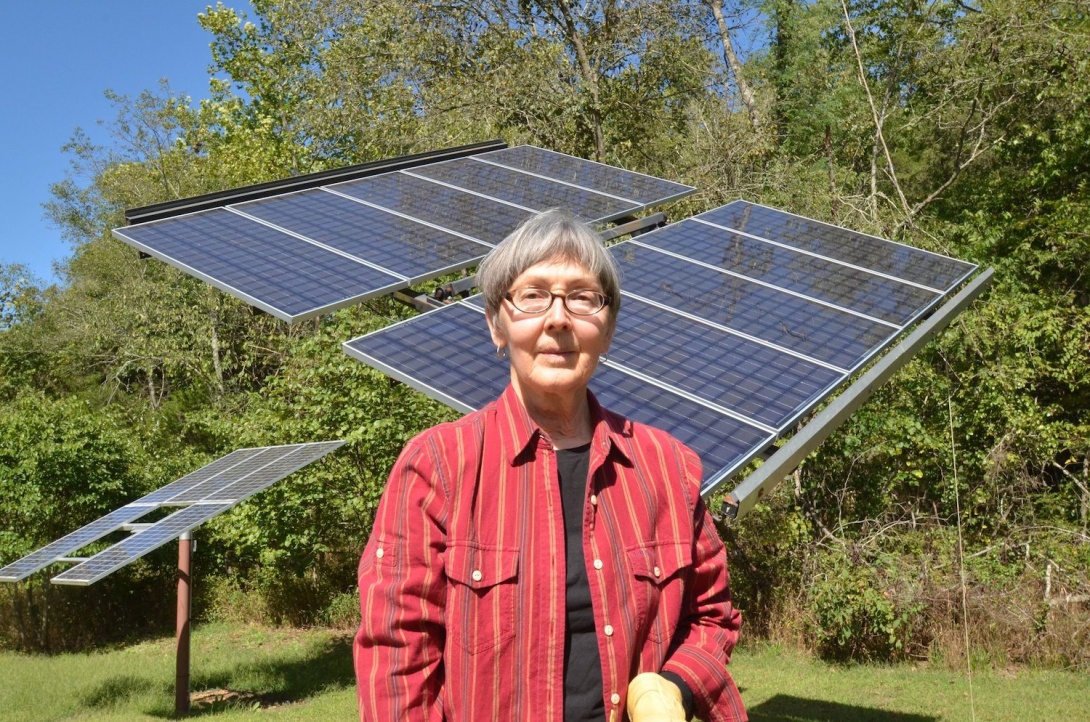INSTITUTE INDEX: How Build Back Better would transform dirty rural electric systems

Environmental scientist Pat Costner, pictured here, was the first customer of Carroll Electric Cooperative in rural Arkansas to tie her residential solar system to the electrical grid, allowing her to power her home and send the excess back to the system. A provision in the Build Back Better Act now under Senate consideration would help rural electric cooperatives like Carroll shift their generation mix away from fossil fuels to cleaner sources like solar and wind. (Photo by Save the Ozarks via Flickr.)
Amount in funding the $1.8 trillion Build Back Better Act provides for a new rural energy program called "Clean Energy Repowering for Rural Utilities," which would offer grants and loans to help rural electric cooperatives transition from fossil fuels to renewable energy sources: $9.7 billion
Percent of the U.S. land mass now powered by electric cooperatives, consumer-organized and -owned nonprofits enabled by 1930's-era New Deal initiatives to bring electricity to rural communities that had not been well served by for-profit power companies: 56
In the mid-1930s, percent of rural U.S. homes that lacked electric service: 90
By 1953, percent of U.S. farms that had electricity, thanks in large part to cooperatives: 90
Number of Americans today who belong to electric cooperatives, which are concentrated in the South, Midwest, and Great Plains: 42 million
Percent of the Southeast's population that lives in rural communities, which are uniquely vulnerable to climate change due to poverty, economic reliance on the natural environment, and other factors: 20
Percent of what are known as "persistent poverty counties" — those with a relatively high poverty rate over a long period of time — that electric cooperatives serve: 92
Of the 13 most carbon-intensive electric utilities in the U.S., number that are rural electric cooperatives, which face special challenges in transitioning to cleaner energy sources: 9
As of 2019, percent of cooperatives' generating capacity that came from coal, the most carbon-intensive fossil fuel: 57
In comparison, percent of investor-owned utilities's generating capacity that came from coal: 31
Renewables' percentage share of electric cooperatives' generation mix in 2019: 19
Percentage-point gain that represents over the preceding five years: 6
Amount Build Back Better gives over a decade to the Rural Energy for America Program, which provides guaranteed loan financing and grant funding to farmers and rural small businesses for renewable energy systems and energy efficiency improvements: $2 billion
Including the Clean Energy Repowering and Rural Energy programs, total amount Build Back Better would invest in rural prosperity and sustainability: $18.3 billion
Earliest date by which Senate Majority Leader Chuck Schumer has reportedly said he could hold a vote on the bill: 12/13/2021
Date on which Sen. Joe Manchin — the West Virginia Democrat who along with Arizona Democrat Kyrsten Sinema has blocked key parts of their party's agenda — met with Schumer to discuss the bill's clean energy provisions, some of which have already been cut because of his opposition: 11/30/2021
Reported value of Manchin's holdings in Enersystems Inc., the coal brokerage he founded: between $1 million and $5 million
In the first three quarters of this year, amount in contributions Manchin received from corporate interests opposed to Build Back Better: more than $1.5 million
Factor by which that surpassed what he raised over the same period last year, raising corruption concerns: 14
Number of West Virginia counties served by the Harrison Rural Electrification Association, the state's sole electric cooperative, which says it was formed in 1937 by "rural citizens who could not or would not be served by the for-profit electric utilities": 7
Estimated cost of the 11 extreme weather events that West Virginia experienced between 2010 and 2020: $2 billion
(Click on figure to go to source.)
Tags
Sue Sturgis
Sue is the former editorial director of Facing South and the Institute for Southern Studies.
